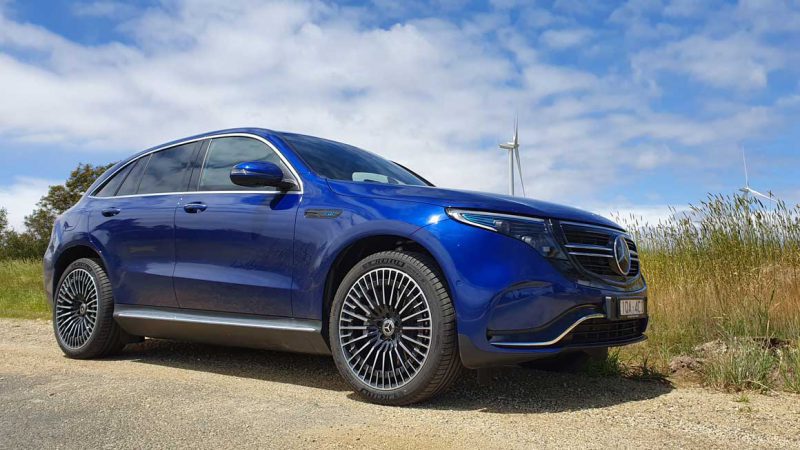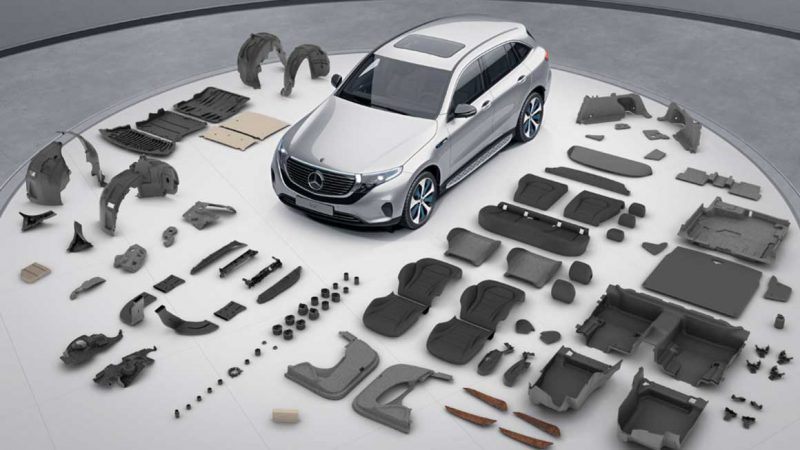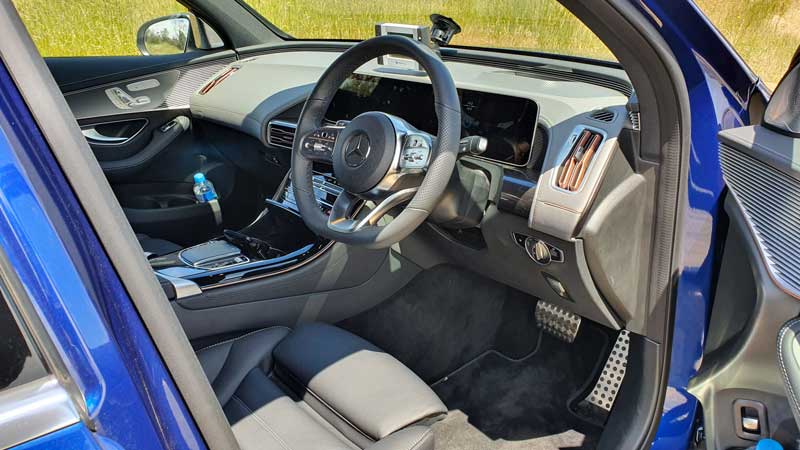The Mercedes-Benz EQC 400 4Matic will be added to nine showroom floors around Australia this coming Monday, and to give you a taste of the German car maker’s first foray into electric mobility we were invited to experience and review the vehicle in its debut Australian drive day.

There’s a well known saying: you get what you pay for. And to put it frankly, with a Mercedes-Benz you certainly do pay: In this case it $137,900 before on-road costs, but this all-electric SUV offers all the bells and whistles, even if you do need to pay extra for some.
The EQC 400 is styled with the signature Mercedes-Benz high-end AMG brand, and is available in 7 standard colours as well as three “designo” extras. We take the brilliant blue with the standard but comfortable grey interior.
Comfort and spaciousness have been first and foremost on the minds of the EQC 400 designers in the interior, ensuring the first experience of the EQC 400 has all the hallmarks of the usual Mercedes-Benz luxury.
And the company credited with the invention of the internal combustion engine, is also keen to underpin the environmental credentials of the EQC 400 with a range of internal initiatives including upholstery made of 100% recycled PET plastic bottles, to renewable materials such as hemp, wool and something called kenaf.
There is a paper honeycomb used in the load compartment floor, and all in all Mercedes-Benz packs some 100 sustainably-minded components into the EQC 400 depending on options chosen.

But it is what lies underneath that demands most attention.
The EQC 400 is destined to compete against the Tesla Model X (which starts at $133,900 for the Long Range and $151,900 for the Performance model) and the mid-range Jaguar I-Pace SE, which starts at $135,400.
With dual asynchronous motors putting out 300kW and 760Nm torque, the 2.4 tonne all-electric EQC 400 has the ability to accelerate from 0-100km/hr in 5.1 seconds.
It does not disappoint; despite the sheer weight of the vehicle, it feels light to drive and does not hesitate when the traffic lights turn to green or there is a need to hotfoot it through traffic.
Driving on a range of roads from highways to country curves and narrow bridges, the handling is nimble and with the low centre of gravity due to the battery pack in the floor, body roll is minimal and safety does not feel compromised on corners.
Four levels of energy recuperation are available to shift between using paddles behind the steering wheel, from D+ (which is the closest to coasting you will get with the EQC) through to D– which is the heaviest.
The difference between each level was a little too heavy handed for my liking, and there is apparently a setting that sets the regen level according to topography which we didn’t have time to check out – something to test out next time, but I imagine I’d prefer the manual control.
There are also some shortcomings, mostly to do with driving range.
With a 80kWh battery (which Mercedes-Benz is sure to emphasise is usable capacity) and 353km driving range under the mildly optimistic WLTP European driving cycle, it has considerably less driving range than the Model X Long Range (which has 528km range using the more accurate US-based EPA rating).
Against the Jaguar I-Pace, which is rated for 377km using the US-based EPA system, it also falls short.
Mercedes-Benz has not yet put the EQC 400 through the EPA ratings, but when it does so we expect it will come in closer to 300km in real world driving range.
We started our 220km trip with 343km range.
After 30km we had already reduced the visible range by 50km, and at 140km, with 80km left on the planned route, we had around 140km driving range left.
That was enough to reach our destination but given the fluctuating range shown in the display, we’re glad we didn’t get lost.
Still, the EQC 400 will probably only be used for meandering country roads on the weekends.
During the week it makes a perfect cocoon for eco-conscious families – although given Mercedes-Benz’ report that the ages of those making initial purchase orders ranges from 18-86, it won’t be restricted to the soccer mum set.

For those that do purchase the EQC 400, they will have the option to be treated to Mercedes-Benz’ new MBUX user experience, which builds on the previous system with double 10.25″ touchscreens.
A new addition to the MBUX however is the clicky touchpad in the centre console which is used for navigating the lefthand screen- it was the one let down in the digital experience that I feel Mercedes-Benz would do well to improve upon.
One option we think would be great to consider if purchasing is the augmented navigation, which overlays instructions onto a camera-fed display of what’s ahead; while we didn’t get to try it, the addition of city buildings to the standard nav system greatly helped getting around the city.
Overall, the EQC 400 will likely delight those who take it for a test drive – and as long as you take it easy on the pedal the range is enough for everyday driving needs.
That’s if you can get your hands on a demo model: just 9 dealerships will take a display and demo model next Monday and word is that unless you are happy to take what is available, you will be waiting until the second half of 2020 for an optioned model.
Once supply is ramped up however customers will no doubt enjoy the transparency of pricing and ability to order online thanks to a new business model being rolled out by Mercedes-Benz for the EQC400, a first for the German car maker in Australia.